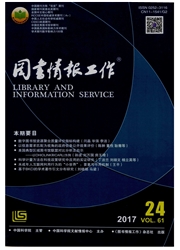

 中文摘要:
中文摘要:
科技期刊的发展过程中,必然会面临着来自于同学科其他期刊的竞争压力。期刊自身与竞争对手的绝对影响力、期刊之间的相似性程度与期刊的竞争强度密切相关。我们将CSTPCD2011收录的1998种期刊归入61个学科类别,把每一个学科类别作为一个期刊生态系统,引入生态学领域竞争强度的测度方法,采用CSTPCD2011数据库的期刊指标和引文数据进行测算。计算过程中,以期刊的总被引频次作为衡量期刊绝对影响力的指标,计算学科分类内期刊互引矩阵、期刊相似性矩阵、并进一步计算期刊竞争关系矩阵。以此为基础,研究期刊在学科所面临的竞争压力,以及学科分类的整体竞争强度。研究表明,在物理学类35种期刊这个样本中,期刊的竞争压力差距悬殊,总被引频次大小对期刊的竞争压力有一定影响,同时期刊之间的相似性较大时,彼此的竞争压力都有所增加。研究还发现,各个学科分类的整体竞争强度也有比较明显的差别。综合类和工程技术领域竞争程度偏弱,医药卫生领域竞争程度整体偏强。与此同时收录期刊数量,即学科规模在20~50之间的学科分类,整体竞争强度更高一些。对科技期刊竞争压力的测算,将应用于期刊发展态势研究和发展策略选择,同时还有助于科技期刊管理部门进行科学决策。
 英文摘要:
英文摘要:
Scientific and Technical journals always face competition from others in the same subject or field. Journal's absolute value of impact and the similarity between target journal and others have closely relation to the competition intensity. We class 1998 journals covered in CSTPCD 2011 as 61 subjects group according to CJCR and each journal belongs to only one subject. Thus every subject could be understood as one ecology system made of journals and be measured with the concepts of Competition Intensity in field of plant. The source data is CSTPCD 2011 and the indicator of Total Cites is defined as the absolute value of impact for each journal. For all 61 subjects, we calculate the mutual citation matrix, the cosine similarity matrix, and the competition relation matrix. Then we get each journal's competition pressure and competition intensity for each subject. Analyzing the sample of 35 journals in physics group, we find that the values of competition pressure are very different among those journals, which is resulted by very different total cites and cosine similarity. We also notice that there are vast different among the values of competition intensity in subjects: the values in muhidisciplinary subjects and engineering subjects are lower while most of which in medicine subjects are higher. Furthermore, we find the value is higher in the subjects in which there are 20 to 50 subjects than the value in other subject in with there are less or more journals. The result of this research will be useful to understand journal's competition environment and make right schedule decision for both the operator and manager of scientific and technical Journals.
 同期刊论文项目
同期刊论文项目
 同项目期刊论文
同项目期刊论文
 期刊信息
期刊信息
